After hearing the brief, I sat down and tried to think about the concept. As Jamie suggested, I tried to avoid finding a solution to the problems and find a topic which will lead to asking more questions. In the initial research stage, I came up with a few ideas, but I had to discredit most of them straight away, because they either already existed, or they have already completed solutions.
Early concepts:
1. Theatre simulator
(Q: Can we create an international acting experience, and a platform for small creators to pitch and perform their plays?)
2. Animatic maker
(Q: Can we make independent animations easier to make by creating a VR animatic creation tool?)
3. Tracking settlement on the moon construction
4. Visiting Orion crew
5. Stroke patients’ recovery
6. Life story- a collection of memorabilia
7. AR art gallery
8. Disability and experiencing sex and human physical interaction
(Q: Can we remove taboos and make disabled people able to fulfil their needs without shame?)
9. Garden care/self-sustainability solutions
Early concepts:
1. Theatre simulator
(Q: Can we create an international acting experience, and a platform for small creators to pitch and perform their plays?)
2. Animatic maker
(Q: Can we make independent animations easier to make by creating a VR animatic creation tool?)
3. Tracking settlement on the moon construction
4. Visiting Orion crew
5. Stroke patients’ recovery
6. Life story- a collection of memorabilia
7. AR art gallery
8. Disability and experiencing sex and human physical interaction
(Q: Can we remove taboos and make disabled people able to fulfil their needs without shame?)
9. Garden care/self-sustainability solutions
The most interesting concept to me was using VR technology in the recovery of stroke patients, and the sexual experiences of people with disabilities. It is often a taboo subject not discussed enough in the circles of carers, and it is very important for the well-being of many disabled people. Sex drive simply does not disappear, and there is a huge need to take it under consideration when caring for others. I used it as a starting point for my main research, and whilst doing it I stumbled upon the term ‘touch starvation’. Touch starvation refers to the longing for touch or physical contact from other living beings. It typically occurs when a person experiences little to no physical contact for a prolonged amount of time.
Humans are largely social beings, and some research suggests that many people feel comfort, security, and satisfaction from physical contact. Deprivation of physical touch may result in people experiencing negative sensations, such as feelings of emptiness and loneliness.
Some of the risks of touch hunger are:
• Overwhelming feelings of loneliness
and isolation
• Experiencing depression or anxiety
• Feeling “stressed out” and underappreciated
• Difficulty sleeping
• A sense of dissatisfaction in a personal relationship
• The tendency to self-medicate feelings with drugs or alcohol
• Children don’t generally have the capacity to process or verbalize a lack of physical affection in effective ways, other than acting out
• In children suffering from this condition, loneliness and depression are often expressed through anger or aggressiveness
• Mental health issues
• Development issues
I decided to make a list of the target groups which could profit from a VR touch hunger solution:
• Singles
• People with social phobias• Children with distant parents/abusive household
• Incels in recovery
• People with disabilities
• Children of parents with postpartum depression
• Sexual abuse victims
• People in relationships with intimacy issues
• Social workers of sexual offenders in rehabilitation
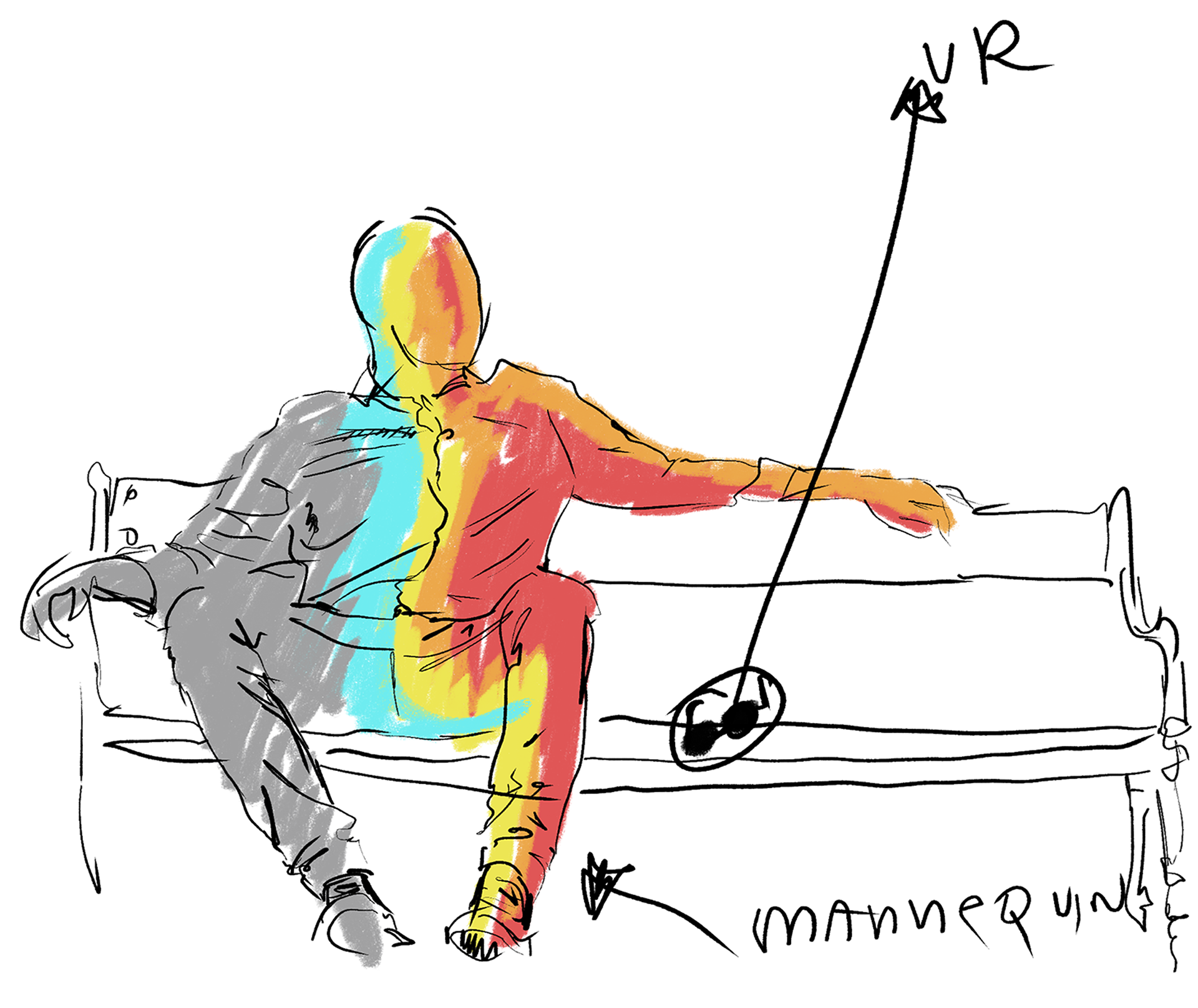
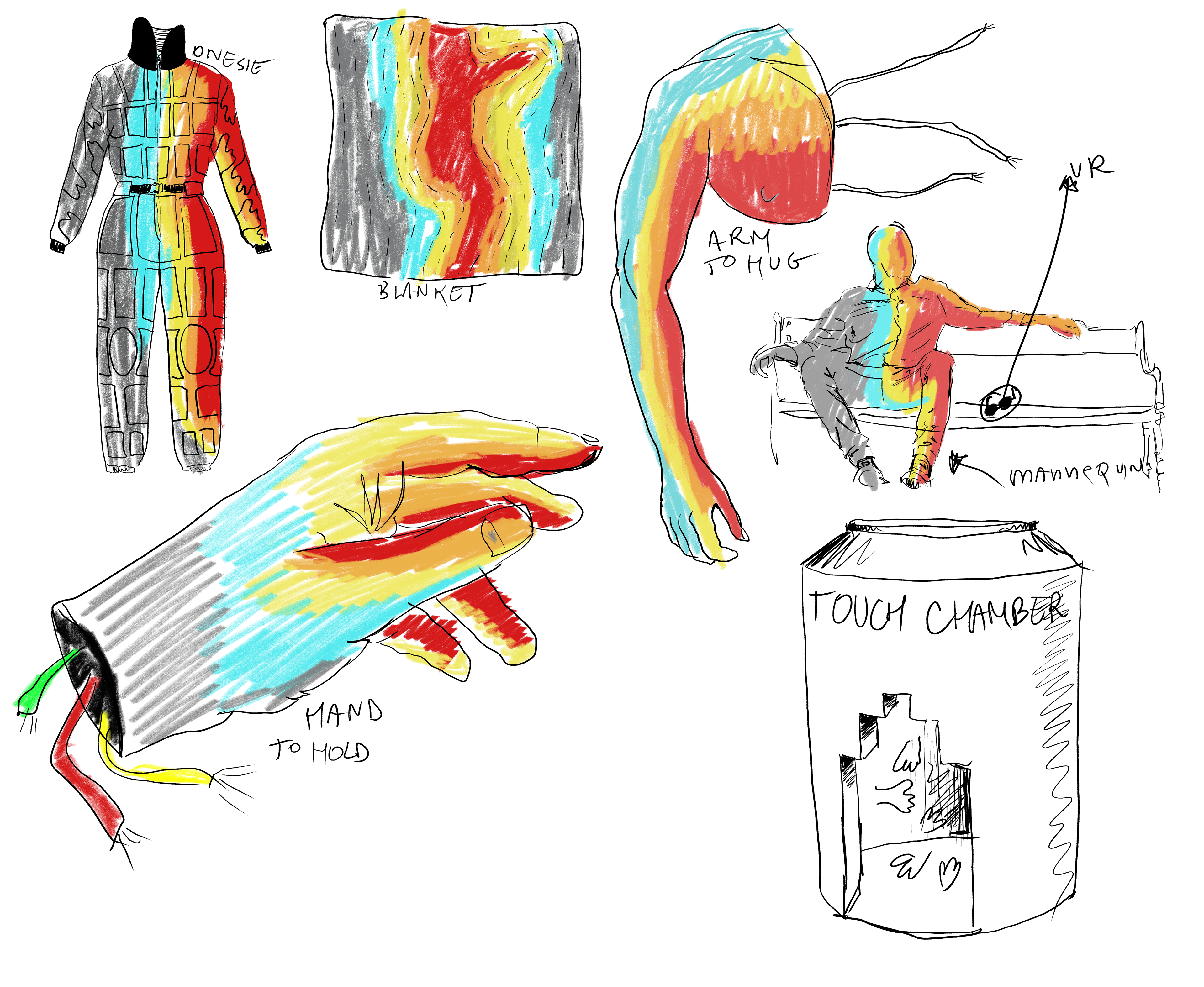
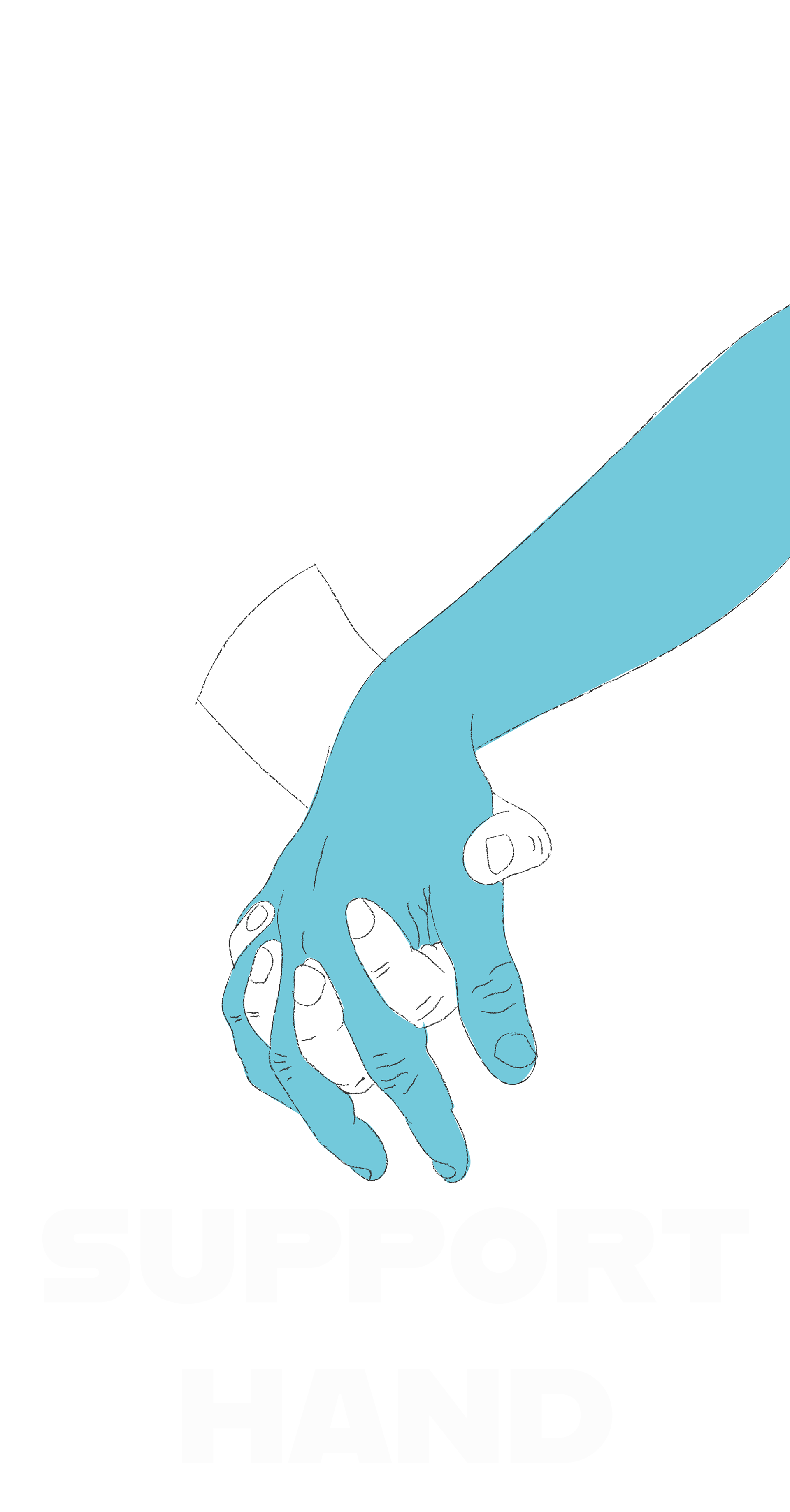
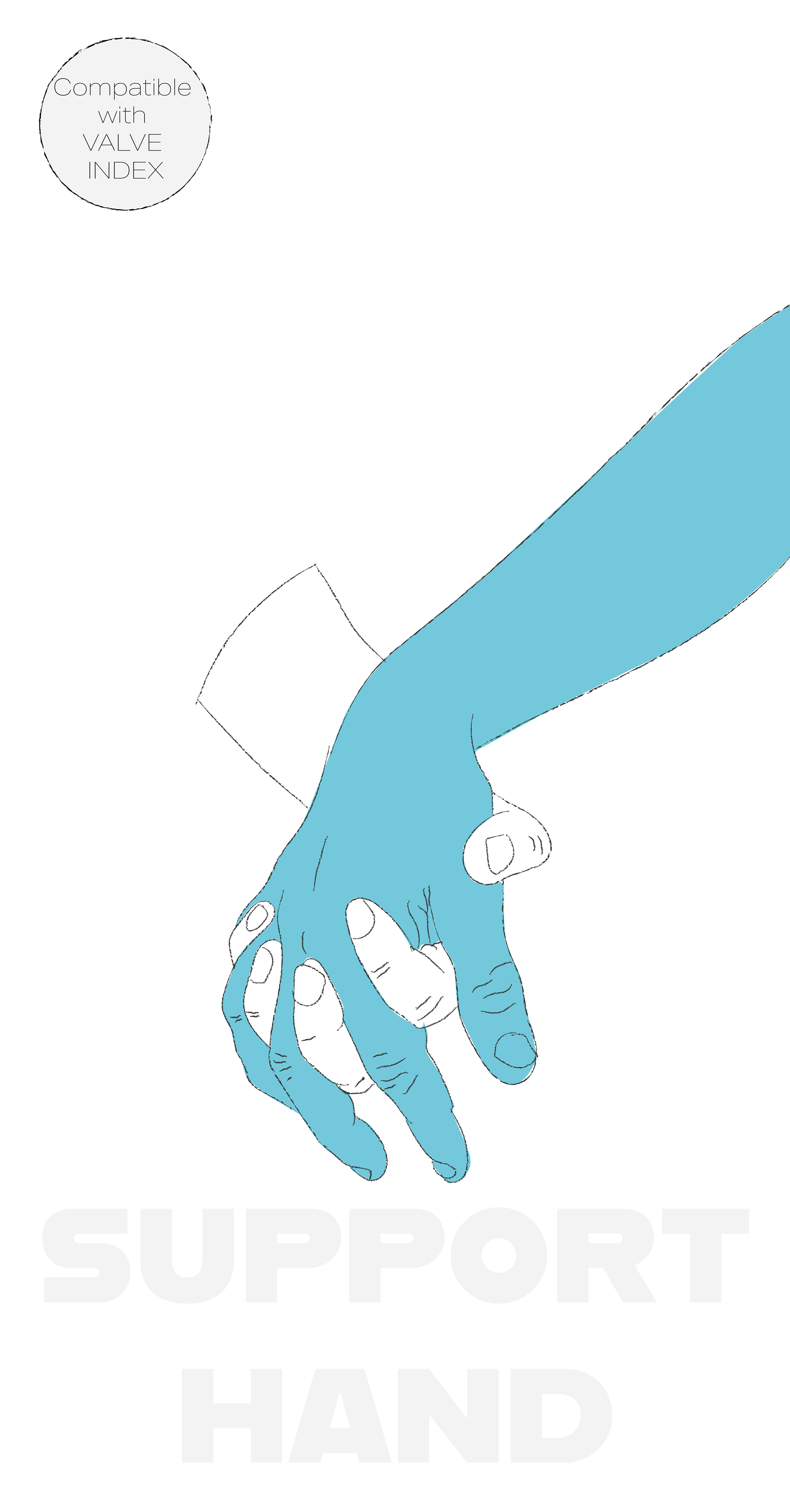
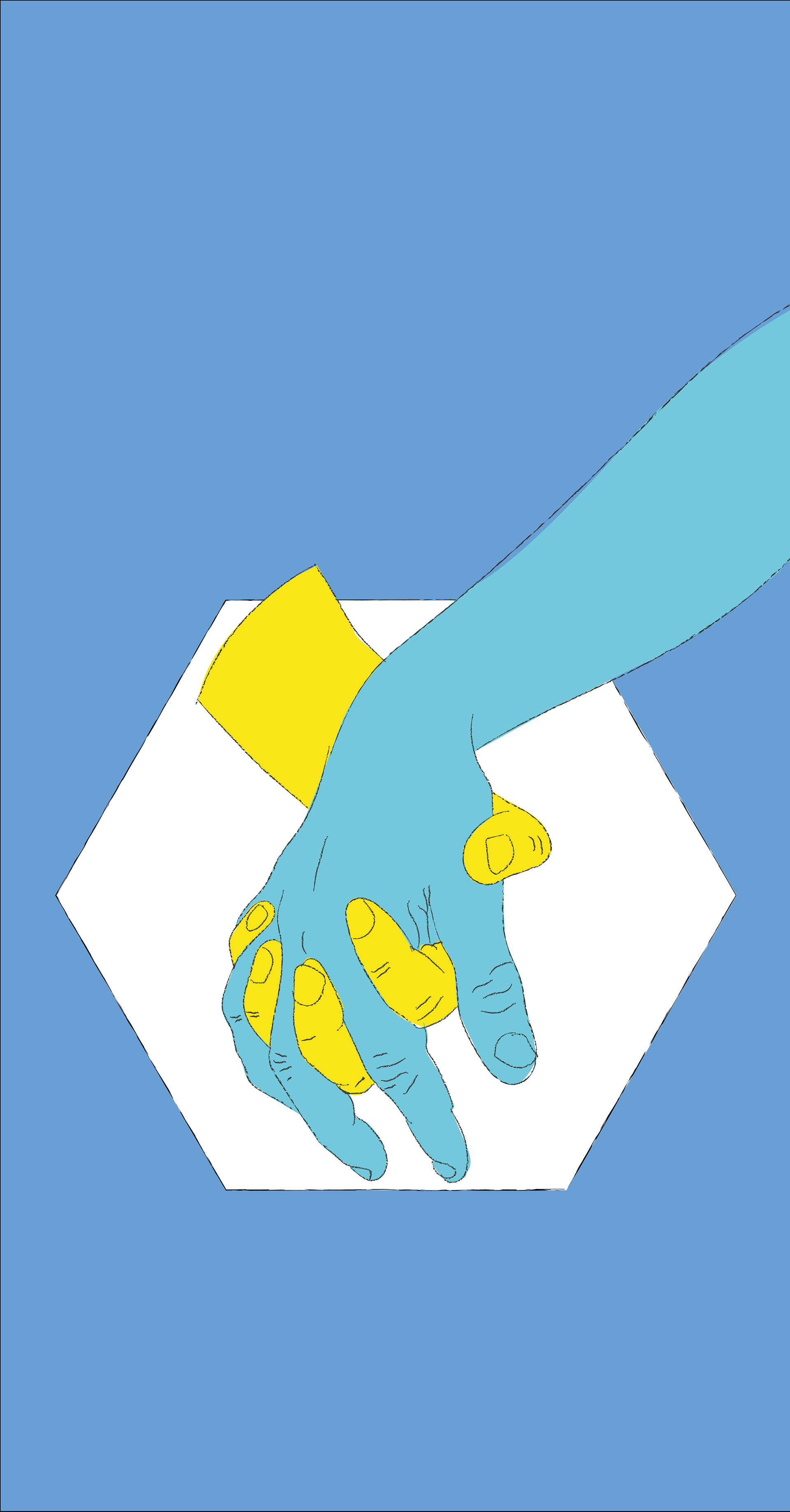
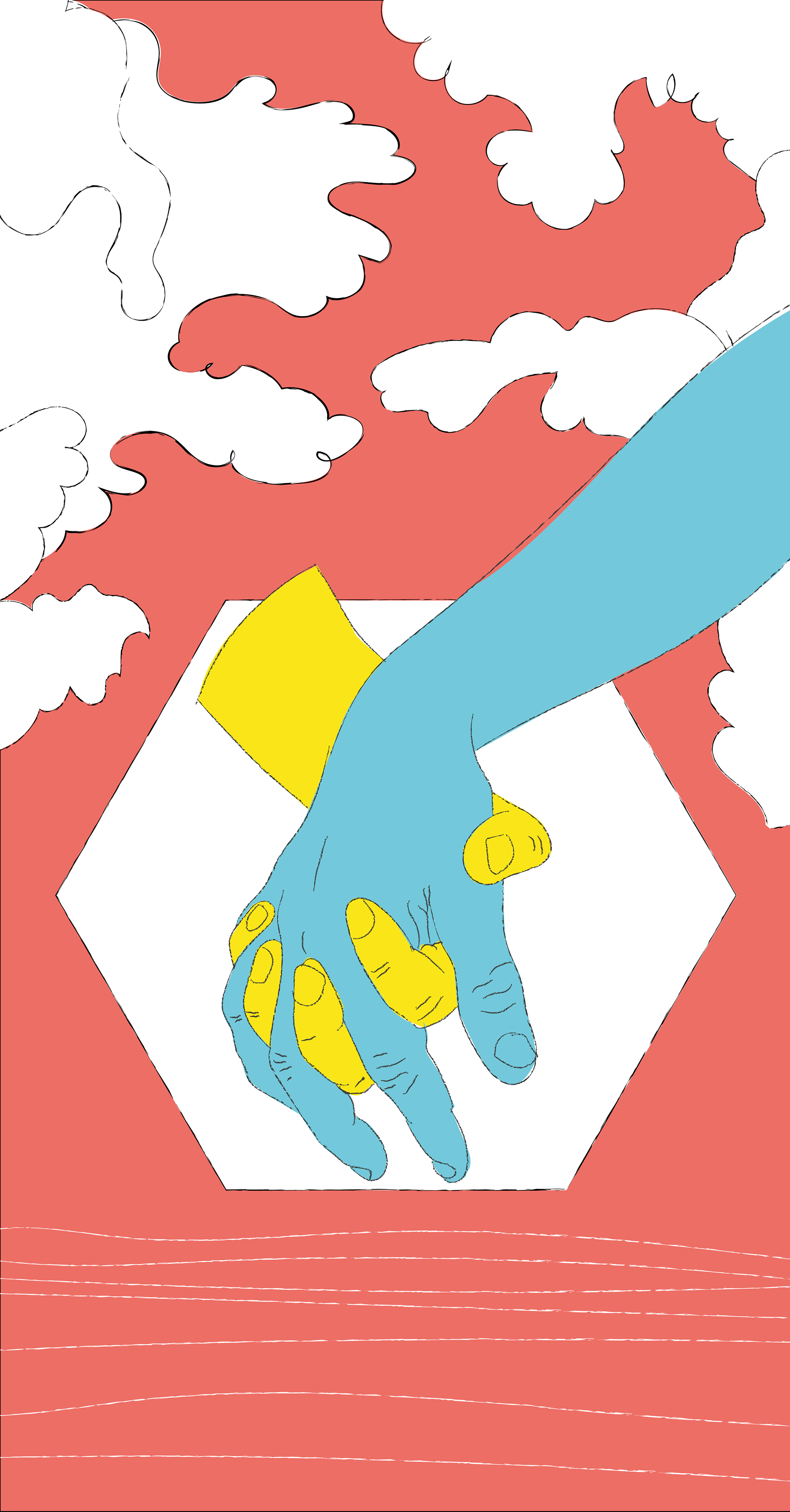
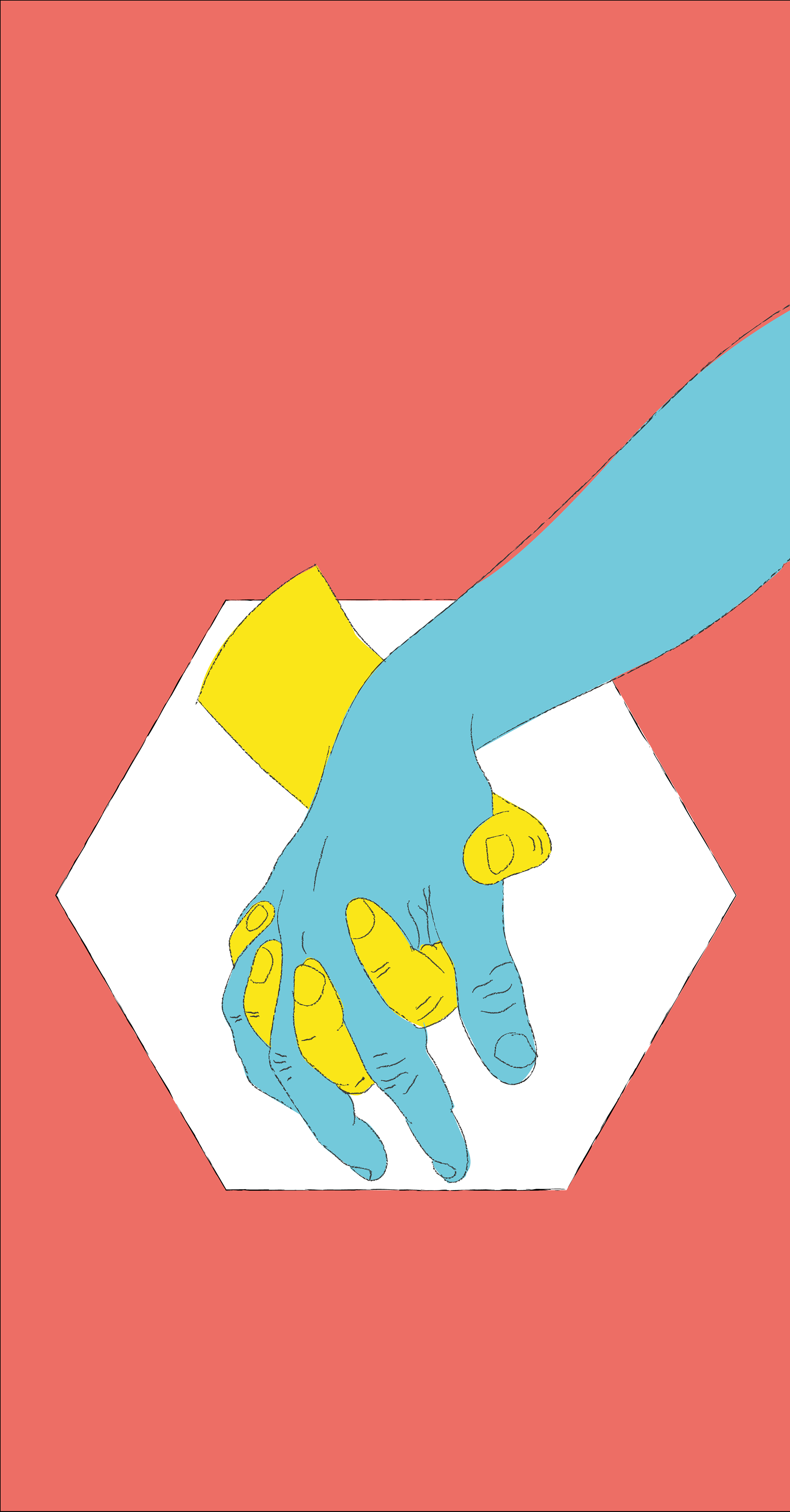
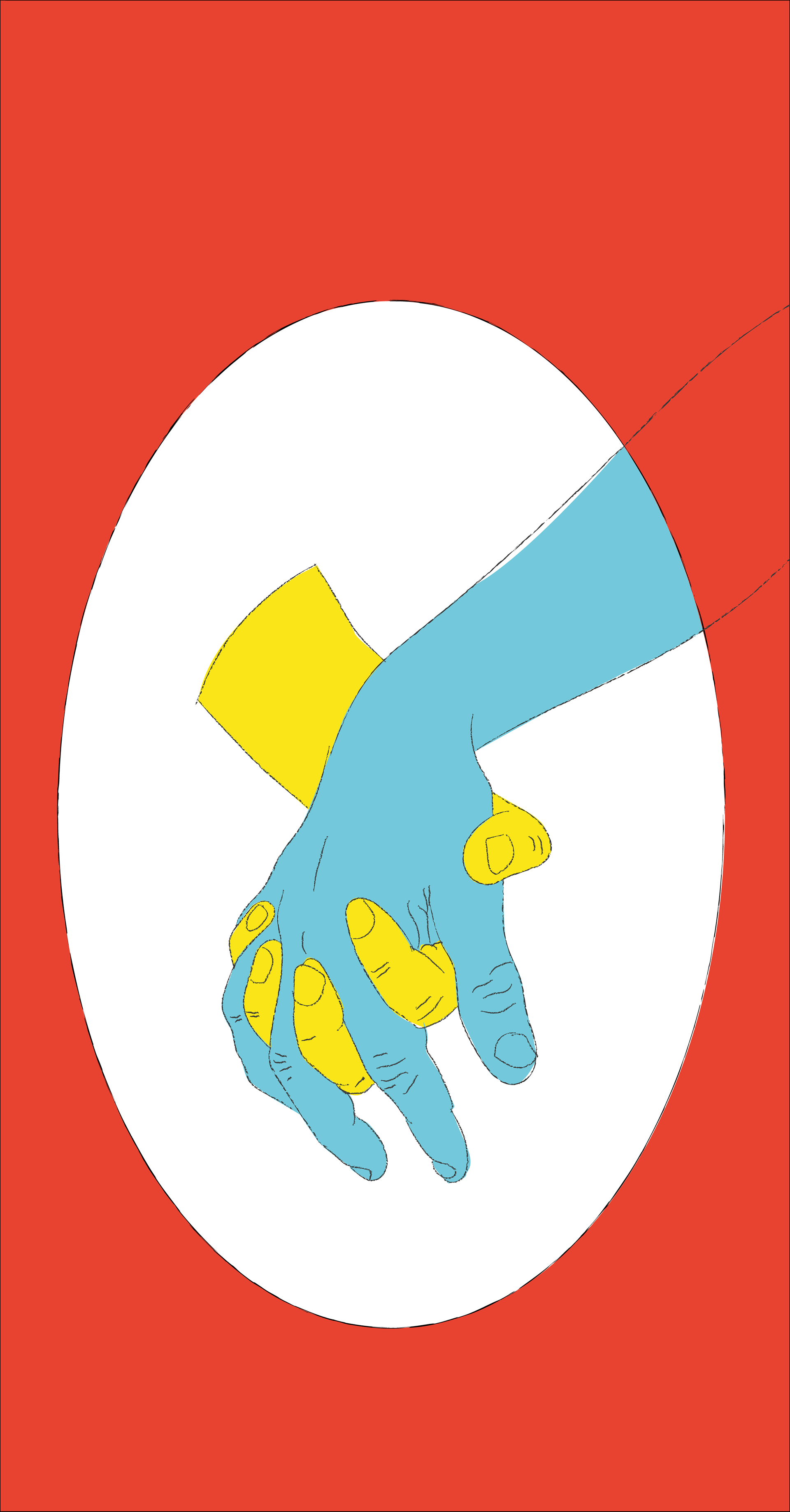
During the presentation when we explored each other’s ideas, Ramon and Ankita pointed out that it might be beneficial to nominate some of the target groups and focus on them. This would allow me to address their needs and the controversy around them in more detail. I decided to choose groups which vary in risks and can lead to different questions when thinking about my project:
- Singles
- Children of parents with postpartum depression
- Incels
- Sexual offenders
The first group seems obvious. People who are single or are in a relationship in which they are lacking intimacy might seek alternatives to meet their needs in multiple ways, including possible VR solutions.
The second group is very often overlooked as there are not many existing tools which efficiently help mothers with post-partum depression. Very often they are left to themselves, with no help and unrealistic expectations towards them. It can lead to serious developmental issues and mental health problems both for the mother and the child or even finish in a tragedy when the mother cannot handle the situation anymore.
It would be beneficial if mothers could access some support, so they can feel comfortable knowing that their kids can still be receiving a healthy amount of the human touch, whilst they can focus on recovery.
The third group refers to incels. Manosphere in general is one of the huge dangers to modern society, and it is important to recognise it as such. We need to educate men and help them separate the fiction they bought into from reality. Therapy and healthy relationships with female VR avatars might be beneficial to start tearing down the walls they built up around themselves and eradicate a threat they pose to society.
All of the groups are categorised to increase a possible controversy of the project, therefore
the fourth group is the most questionable. Sexual offenders and paedophiles are still unpleasant problems from which most of us have the comfort to look away. We can just go savage on them and wish they will cease to exist, but the fact is that they still exist in society after serving their (mostly scandalously low) sentences. The reason why I really wanted to include that group is that after hearing the stories from my friend, who is a social worker, I realised a hard truth – there are people who cannot just look away.
There are people whose jobs include support to the convicts, and it is their burden to do everything in their power to reduce the threat to society and make offenders function in their communities. There are also families of people on the register, which very often are unable to just remove them from their lives.
That is why I was trying to explore a possibility of a VR tool which could help them create a
healthy environment and what risks it bears.
- Singles
- Children of parents with postpartum depression
- Incels
- Sexual offenders
The first group seems obvious. People who are single or are in a relationship in which they are lacking intimacy might seek alternatives to meet their needs in multiple ways, including possible VR solutions.
The second group is very often overlooked as there are not many existing tools which efficiently help mothers with post-partum depression. Very often they are left to themselves, with no help and unrealistic expectations towards them. It can lead to serious developmental issues and mental health problems both for the mother and the child or even finish in a tragedy when the mother cannot handle the situation anymore.
It would be beneficial if mothers could access some support, so they can feel comfortable knowing that their kids can still be receiving a healthy amount of the human touch, whilst they can focus on recovery.
The third group refers to incels. Manosphere in general is one of the huge dangers to modern society, and it is important to recognise it as such. We need to educate men and help them separate the fiction they bought into from reality. Therapy and healthy relationships with female VR avatars might be beneficial to start tearing down the walls they built up around themselves and eradicate a threat they pose to society.
All of the groups are categorised to increase a possible controversy of the project, therefore
the fourth group is the most questionable. Sexual offenders and paedophiles are still unpleasant problems from which most of us have the comfort to look away. We can just go savage on them and wish they will cease to exist, but the fact is that they still exist in society after serving their (mostly scandalously low) sentences. The reason why I really wanted to include that group is that after hearing the stories from my friend, who is a social worker, I realised a hard truth – there are people who cannot just look away.
There are people whose jobs include support to the convicts, and it is their burden to do everything in their power to reduce the threat to society and make offenders function in their communities. There are also families of people on the register, which very often are unable to just remove them from their lives.
That is why I was trying to explore a possibility of a VR tool which could help them create a
healthy environment and what risks it bears.
“Technology has evolved faster than our ethics around sex and relationships in those spaces”
- Samantha Bitty
- Samantha Bitty
There are different existing solutions, and to mention some it is possible to buy weighted blankets, human-sized pillows, and there are hugging machines which can be used in therapy. Other advised solutions include pets (which are not a viable solution for everyone), showers, visiting hair salons, dancing lessons or cuddle parties. Most of them can help in the short term, but in the long term, the solutions listed cannot fully satisfy a need to interact with other humans.
I was wondering what the best way would be to present my idea and I decided to create four boxes, each representing a piece of hardware which would respectively work as a tool to access Metaverse. Users would purchase one of the tools (hand, arm, head or vest) and by using a product code, they would be able to
access the TOUCH CHAMBER in Metaverse.
access the TOUCH CHAMBER in Metaverse.
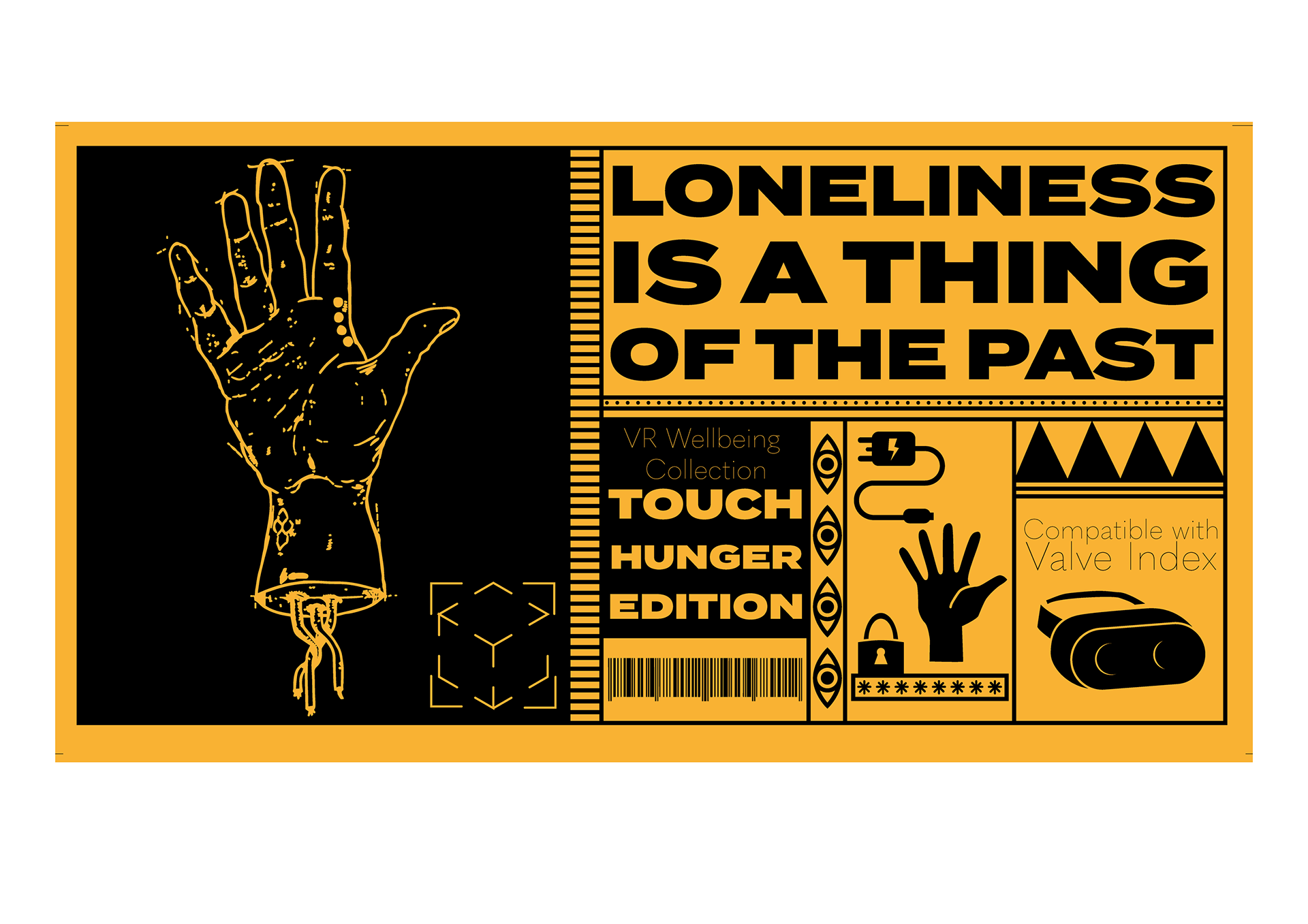
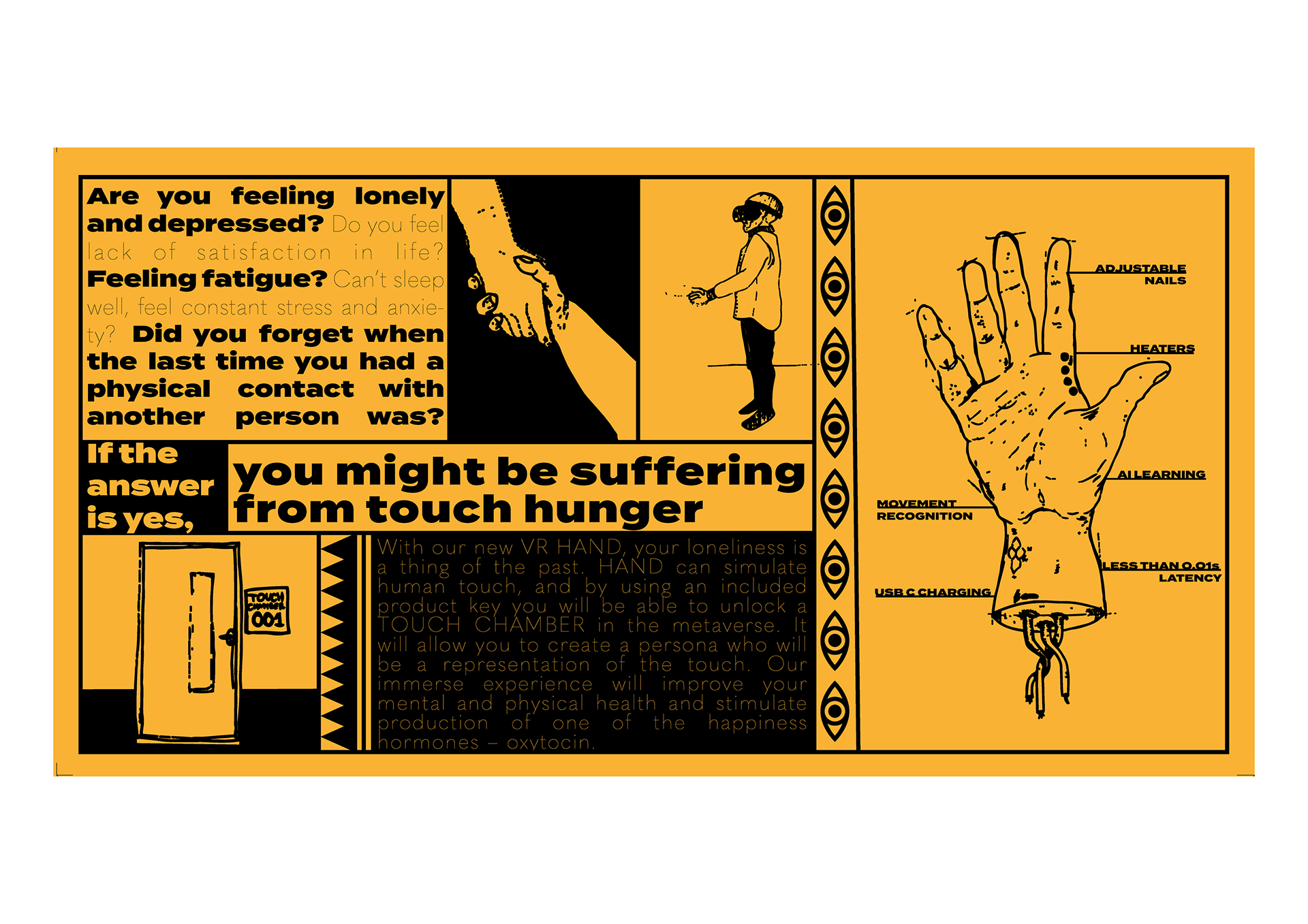
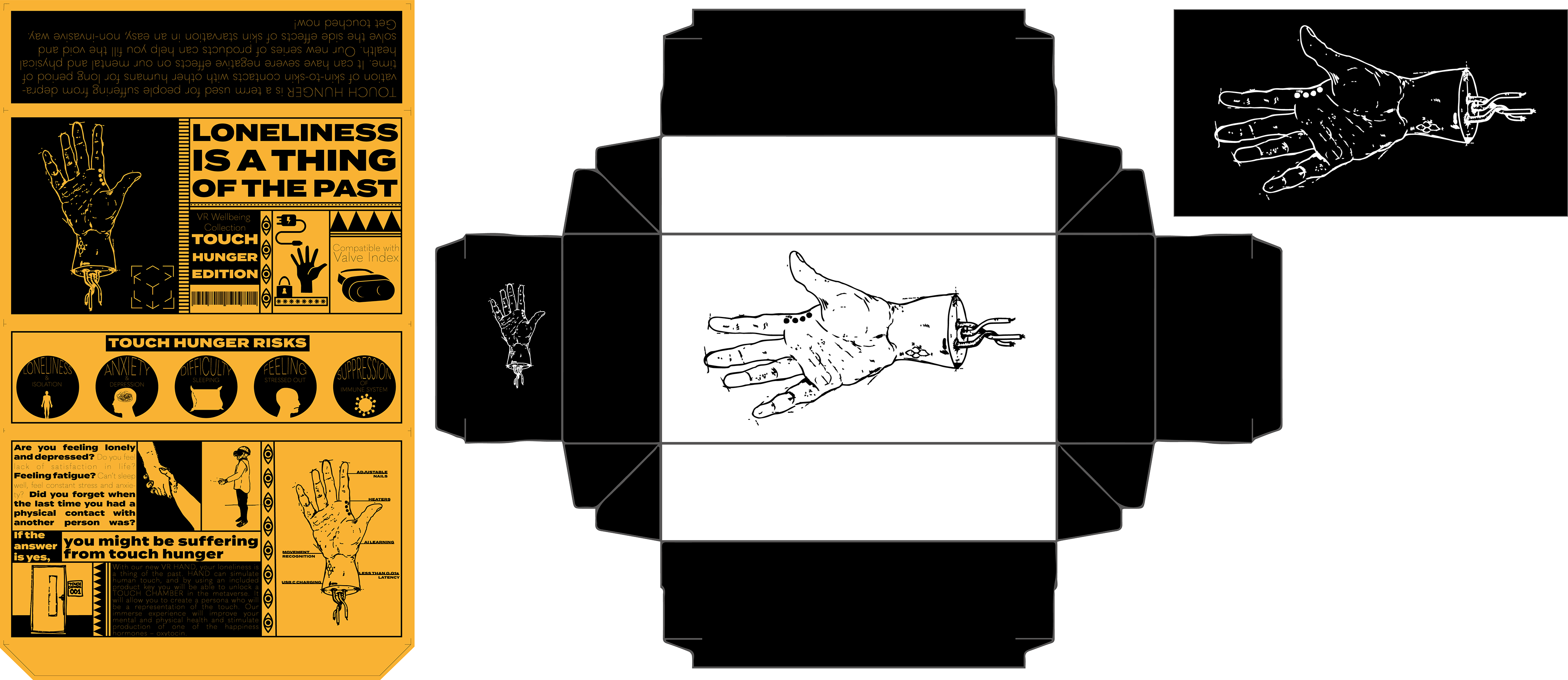
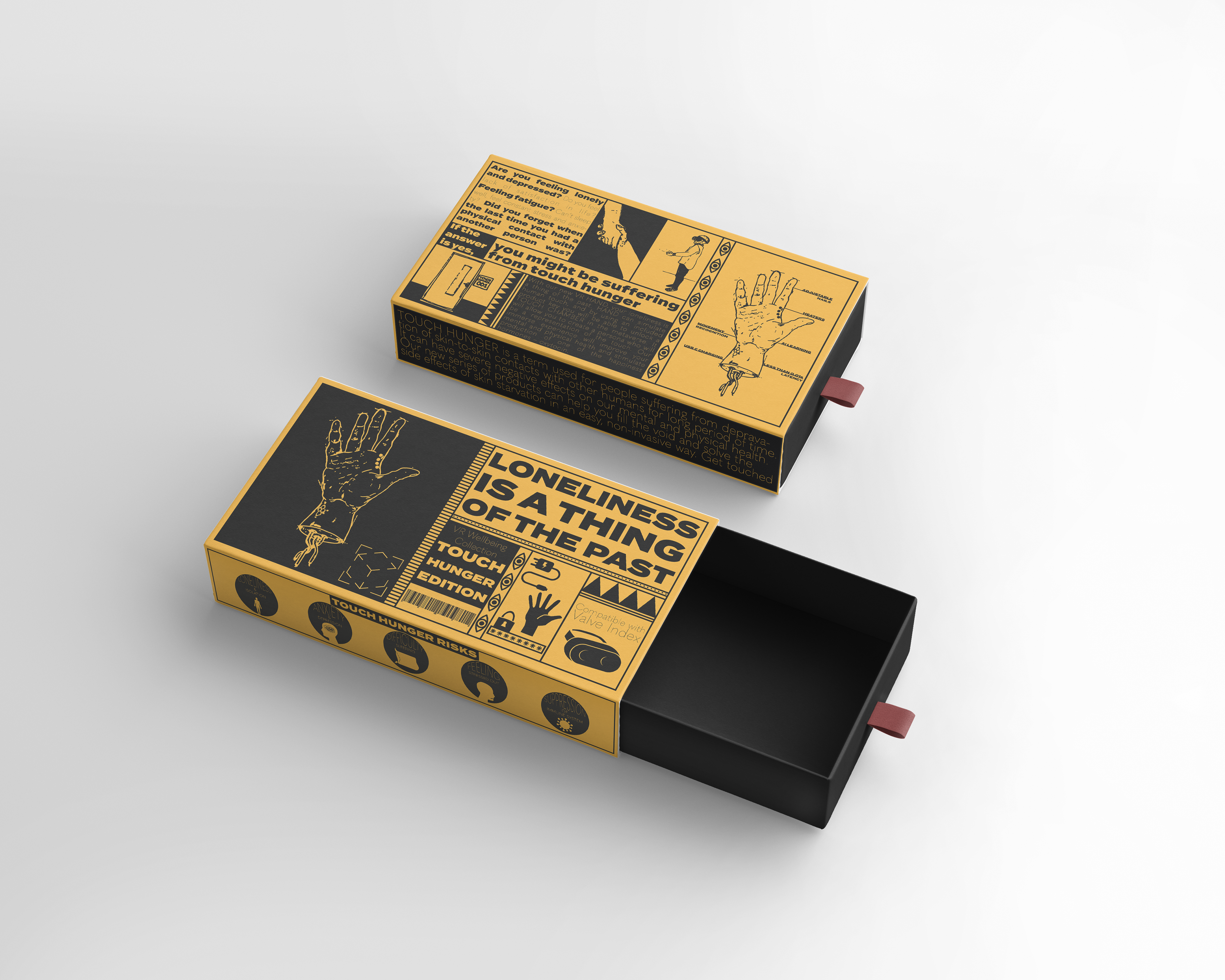
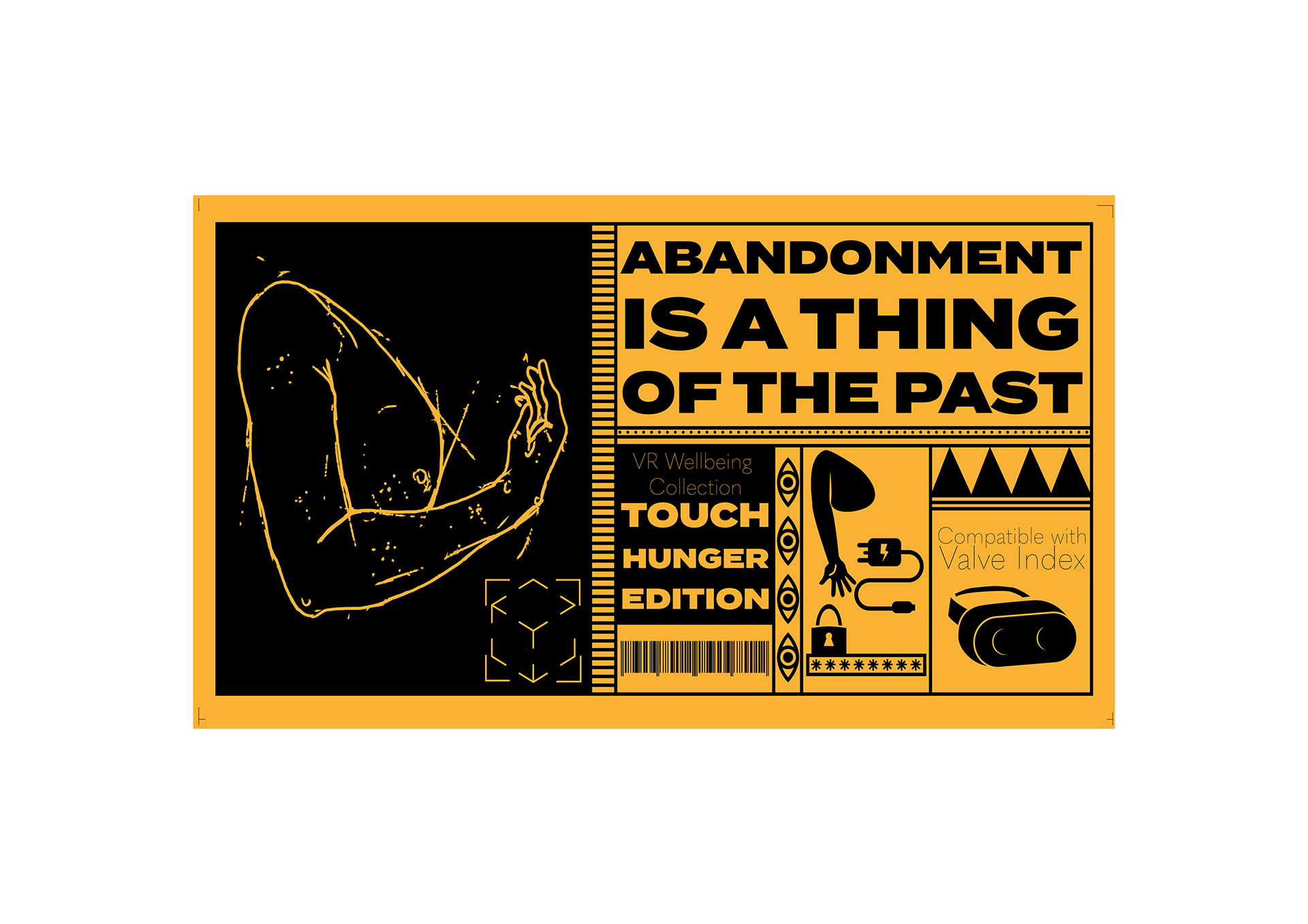
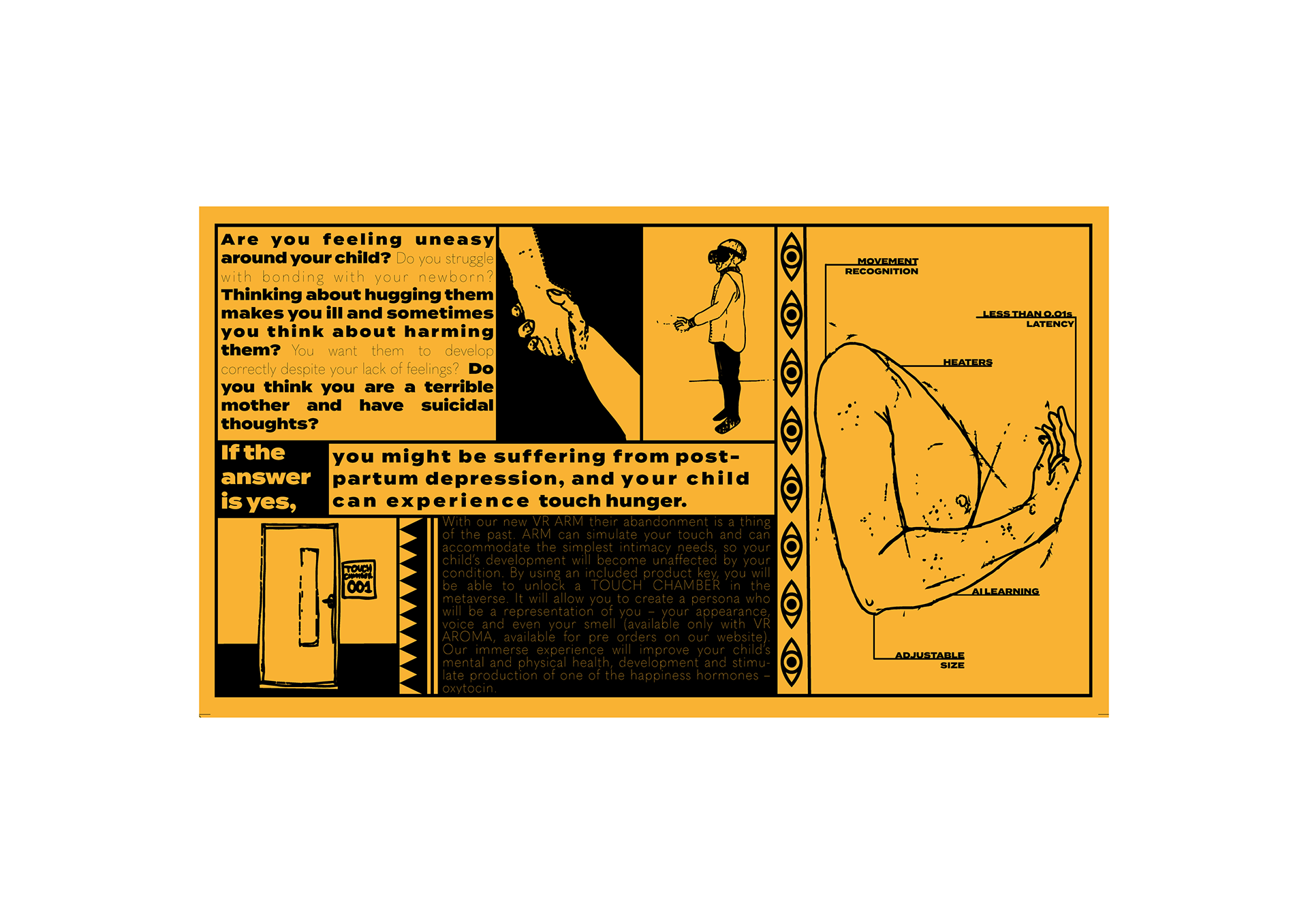
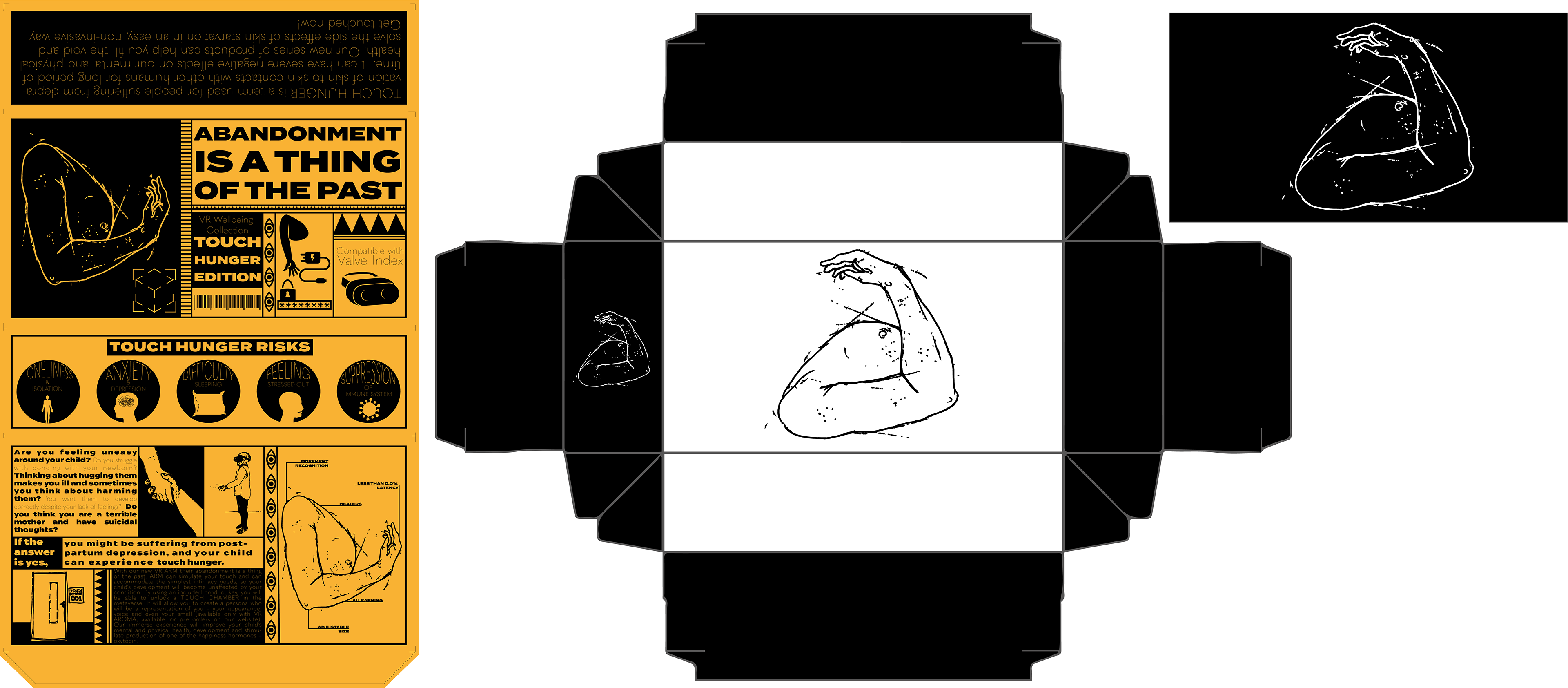
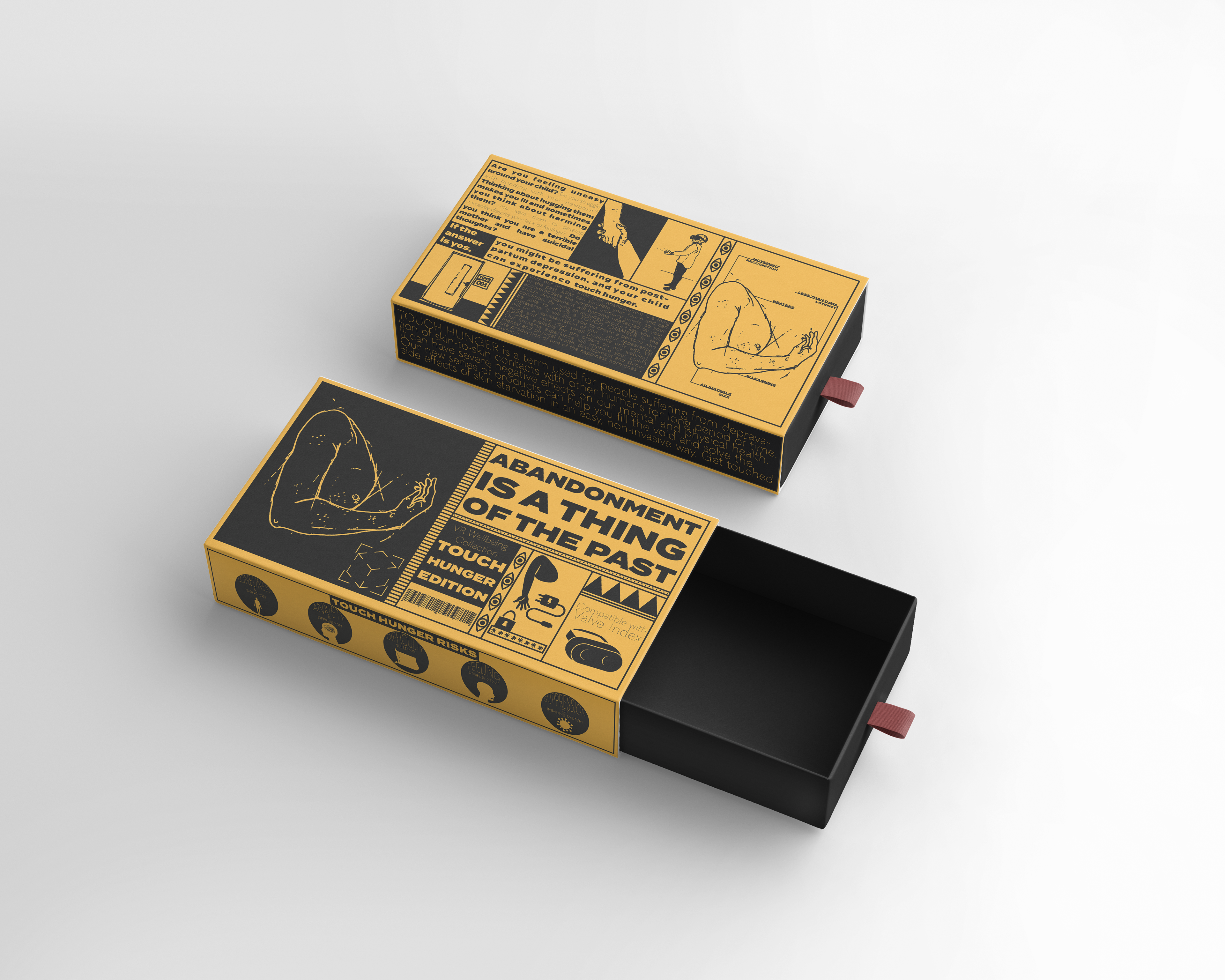
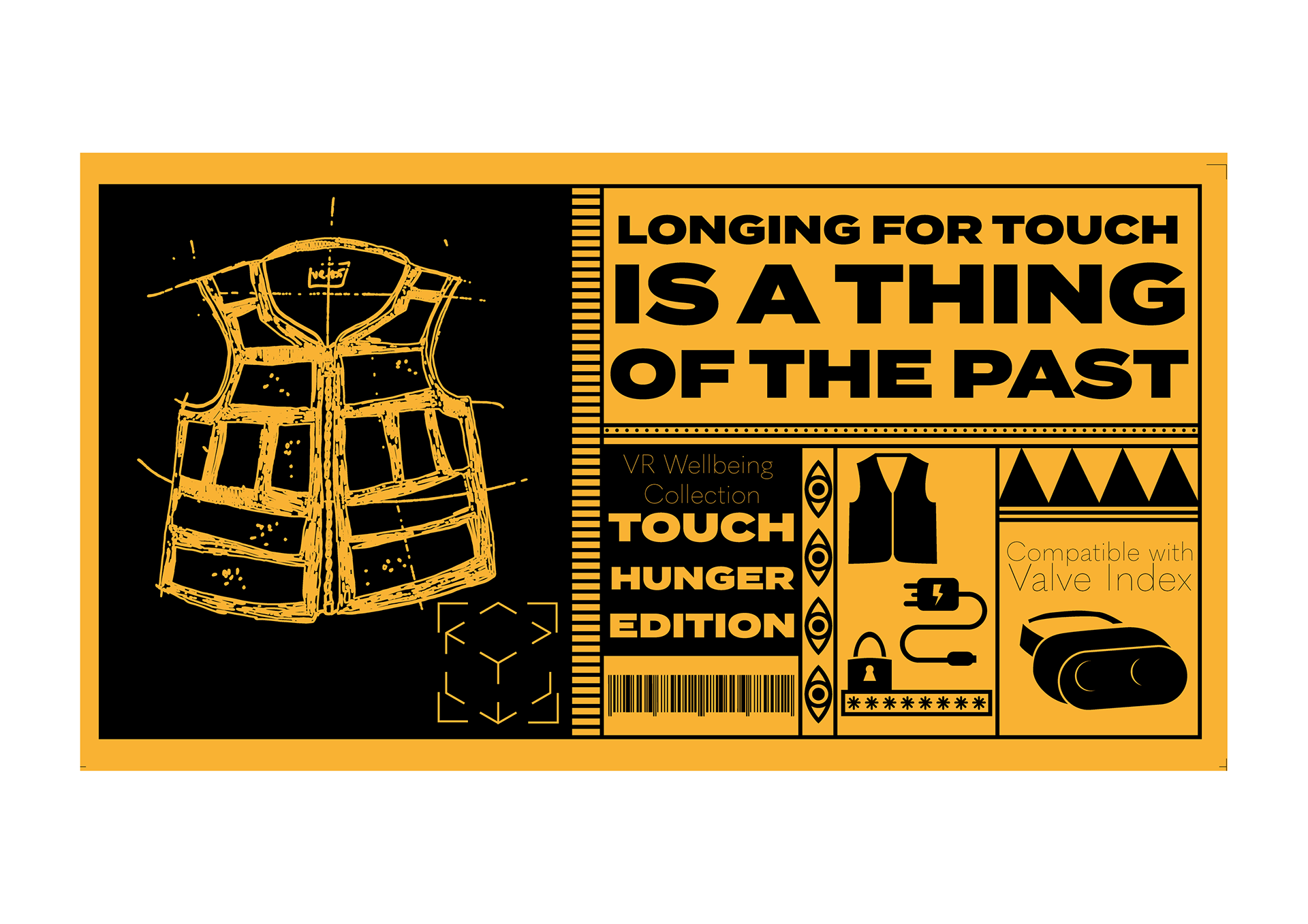
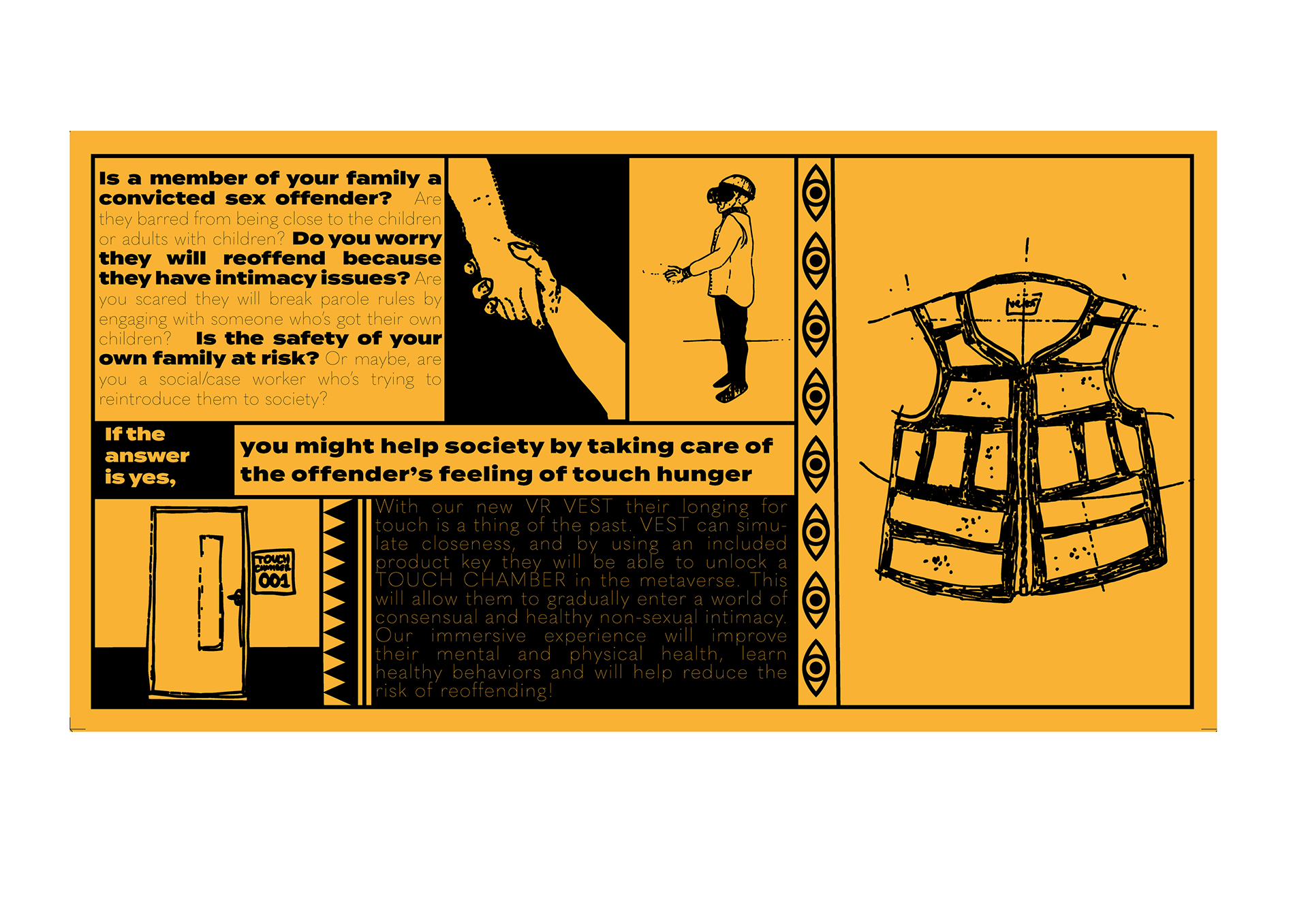
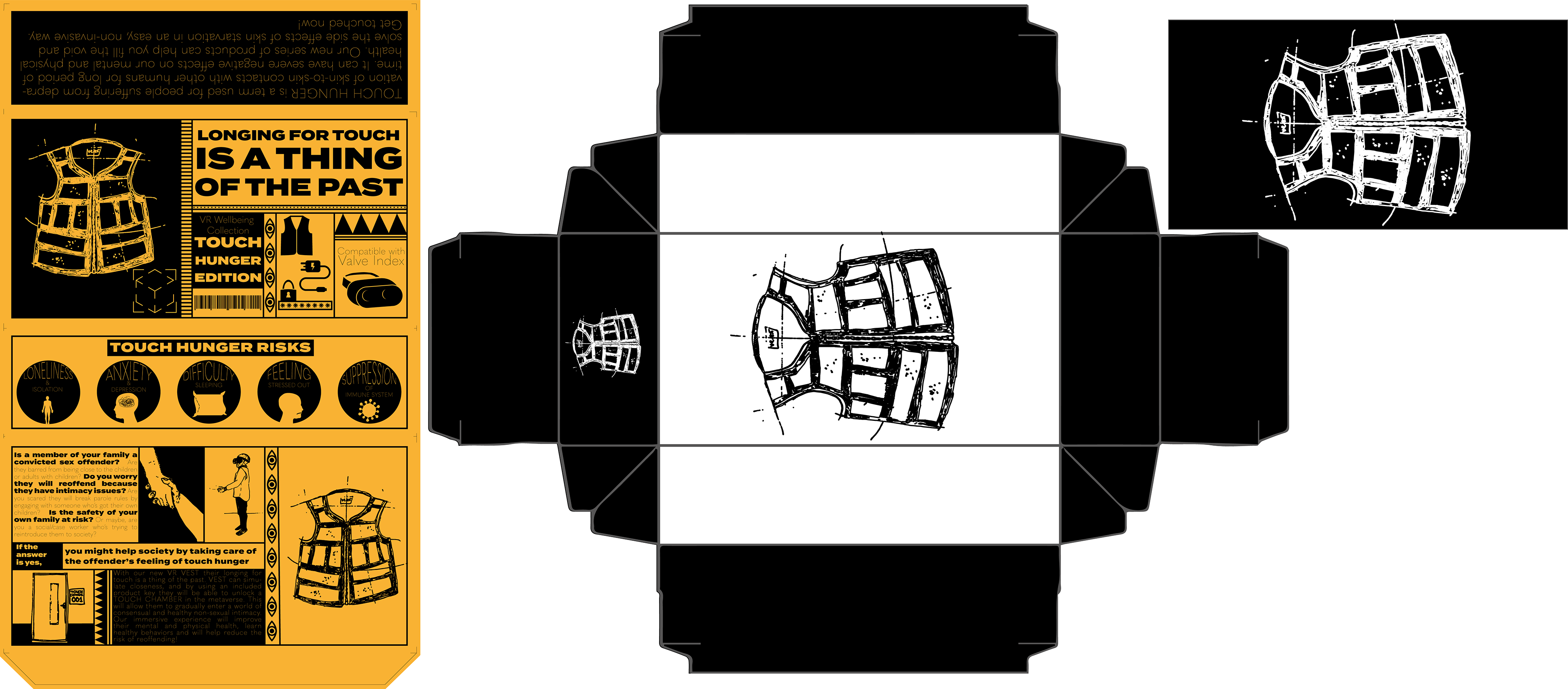
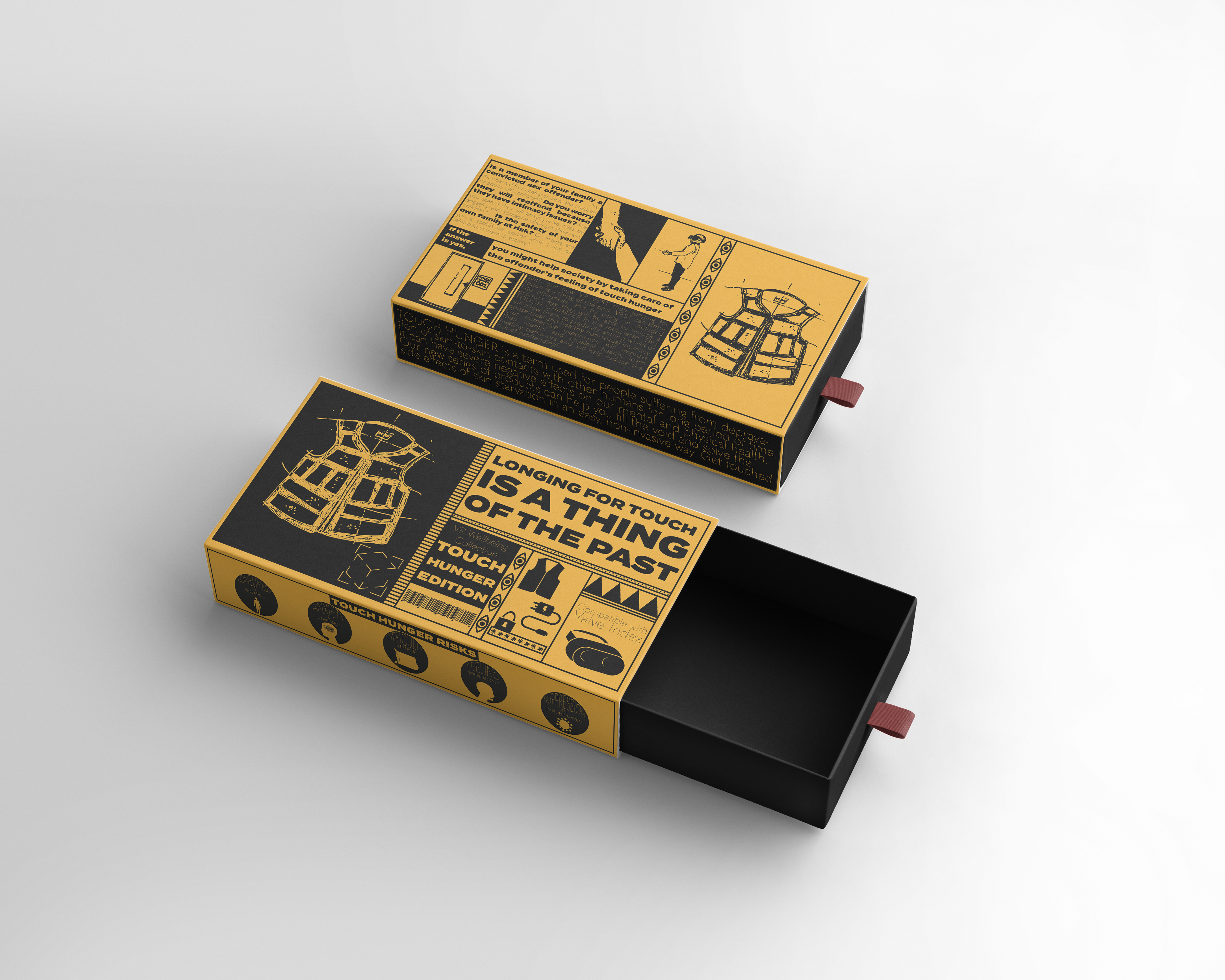
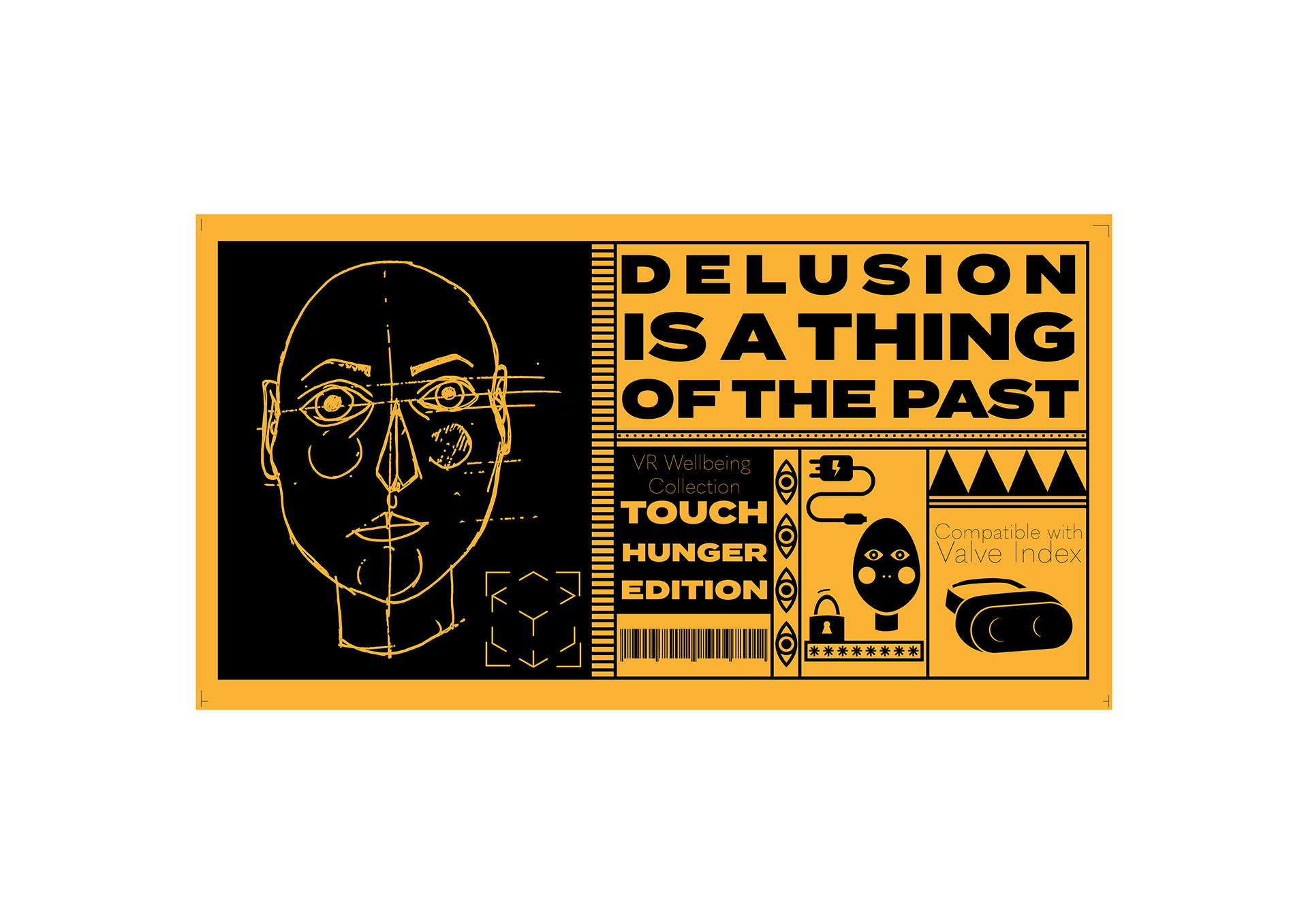
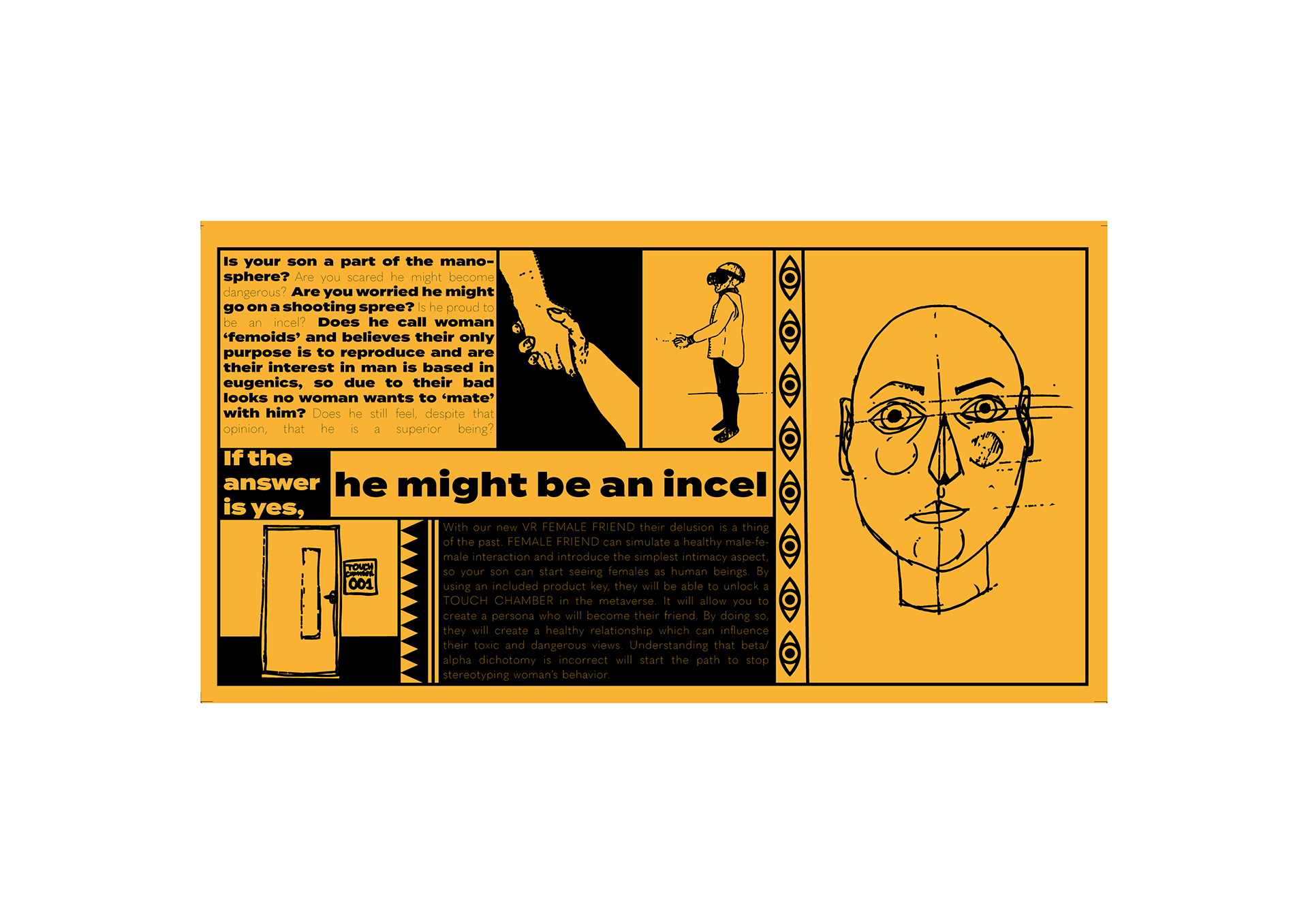

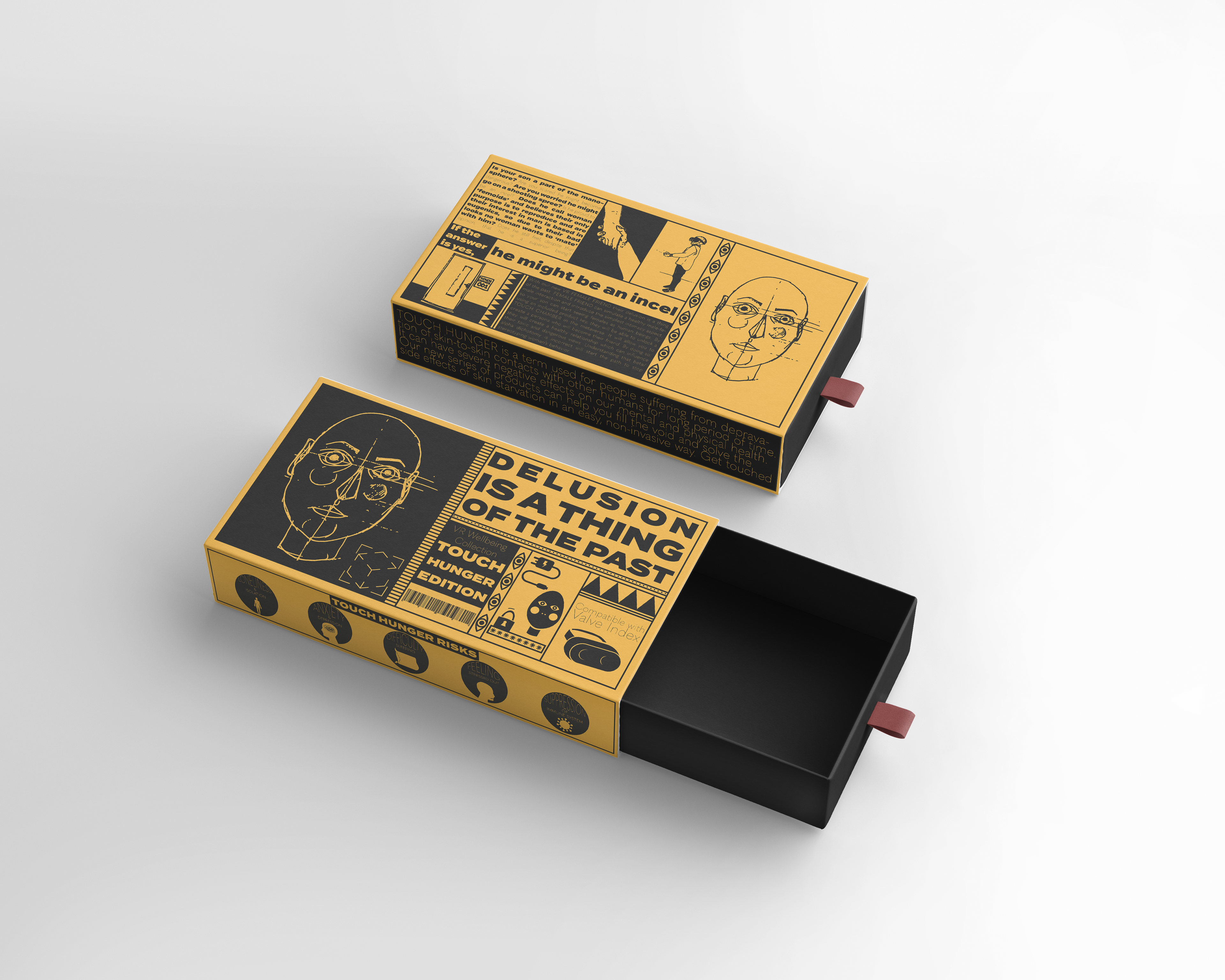
To visualize what TOUCH CHAMBER would be, I created three collages. Users would be able
to personalize it and make it comfortable depending on the type of product – each of them would have a different type of restriction in place. As a critical reflection, I used OpenAI and prompts to create a booklet with a series of articles generated by AI. The booklet itself is a form of design fiction, as it is an AI-powered protest leaflet which could be put together in seconds and used to lobby different ideas. It is a dangerous concept, in which creating propaganda material filled with disinformation and fake news is even easier than it is now, and with the leaflet being dressed up more professionally than Facebook and other social media outlets, it can be a terrible manipulation tool for people without critical thinking skills. Making those articles and quotes, even though I used AI to do it, was a very unpleasant experience. A lot of prompts I had to create to criticise my product were legit
fears dressed up in a lot of misinformation, and quite frankly, in many places, it had been completely opposite of my personal views. It was however an interesting experience, proving how powerful words can be.
to personalize it and make it comfortable depending on the type of product – each of them would have a different type of restriction in place. As a critical reflection, I used OpenAI and prompts to create a booklet with a series of articles generated by AI. The booklet itself is a form of design fiction, as it is an AI-powered protest leaflet which could be put together in seconds and used to lobby different ideas. It is a dangerous concept, in which creating propaganda material filled with disinformation and fake news is even easier than it is now, and with the leaflet being dressed up more professionally than Facebook and other social media outlets, it can be a terrible manipulation tool for people without critical thinking skills. Making those articles and quotes, even though I used AI to do it, was a very unpleasant experience. A lot of prompts I had to create to criticise my product were legit
fears dressed up in a lot of misinformation, and quite frankly, in many places, it had been completely opposite of my personal views. It was however an interesting experience, proving how powerful words can be.
Job advert poster was purposely stripped out from most of the decorative elements, to have a utilitarian look, as I wanted to explore a dystopian reality in which AI-generated art instead of increasing the chance for creativity in designer jobs, strips to purely practical function. I used OpenAI and my prompts to create an ad.